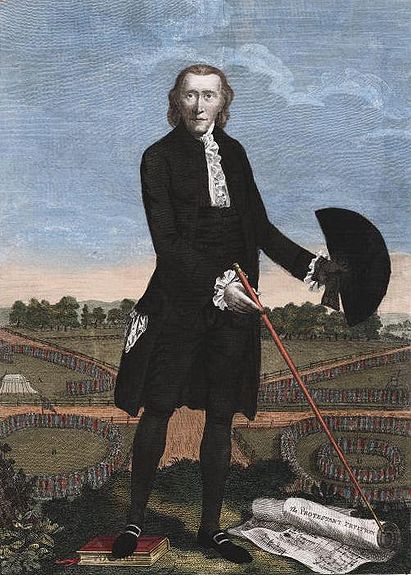
In the first week of June 1780, over 300 people were dead and a good portion of London was either burnt or in ruins. The madness stemmed from a bill that had passed 2 years before and left the residents of London, Bath, and the rest of Great Britain in fear. It was known as the Gordon Riots.

In 1778 the Catholic Relief Act was introduced by the Whig, George Savile, and passed. Although Whigs were traditionally professors of religious tolerance this bill was actually to get more people in the army to fight the American Revolution. The bill absolved Catholics from taking a religious oath which had, until then, prevented them from joining England's forces. The spoilt younger son of the Duke of Gordon, George Gordon was a strong Protestant who had strong feelings against giving Catholics equal rights. He organized the Protestant Association in 1779 in order to upturn the relief act and in June of the following year he marched his followers to Parliament to petition. The group quickly turned into a mob of (at least) 40,000 strong and things quickly got out of hand. Whether this was Gordon's intention or not, we have no idea.
 The crazed mob marched onto the House of Commons and then, with their "No Popery" banners and then proceeded to Newgate Prison and the Clink which were both mostly destroyed. The Clink, which had housed religious prisoners since 1151, was never to reopen. The prisoners were released and joined the mob. For a week while the mob raged and grew worse, Catholics and Protestants alike were prisoners in their own homes while London burned. During the day there was some peace but every night the riots reignited and the injured and drunk could be found among the corpses and ashes. Aristocrats' houses were targeted and some barely escaped with their lives. Edmund Burke, George Savile, the Marquis of Rockingham, Lord Mansfield, Lord North (the Prime Minister) and even the Duke of Devonshire narrowly escaped their wrath. An explosion at a Catholic distillery in Holborn sent gin and rum into the streets. People who went down on their hands and knees to drink the free booze from the cobblestones soon crumpled and died in the streets from the deathly acidic concoction. Reports from the time relate the flames of the city to that of volcanic explosions which reached to the heavens.
The crazed mob marched onto the House of Commons and then, with their "No Popery" banners and then proceeded to Newgate Prison and the Clink which were both mostly destroyed. The Clink, which had housed religious prisoners since 1151, was never to reopen. The prisoners were released and joined the mob. For a week while the mob raged and grew worse, Catholics and Protestants alike were prisoners in their own homes while London burned. During the day there was some peace but every night the riots reignited and the injured and drunk could be found among the corpses and ashes. Aristocrats' houses were targeted and some barely escaped with their lives. Edmund Burke, George Savile, the Marquis of Rockingham, Lord Mansfield, Lord North (the Prime Minister) and even the Duke of Devonshire narrowly escaped their wrath. An explosion at a Catholic distillery in Holborn sent gin and rum into the streets. People who went down on their hands and knees to drink the free booze from the cobblestones soon crumpled and died in the streets from the deathly acidic concoction. Reports from the time relate the flames of the city to that of volcanic explosions which reached to the heavens.The army was finally called in on June 7 and ordered to fire on any group of 4 or more w
 ho refused to relinquish. It is estimated that 285 were shot dead, hundreds more were wounded, and a couple dozen executed. Although Gordon was charged with high treason he was found not guilty. He later was imprisoned for badmouthing Marie Antoinette and was thrown in Newgate, the same prison his mob almost destroyed. Ironically, he converted to Judaism shortly afterward while London was still was rebuilding (years later) from the week-long riots.
ho refused to relinquish. It is estimated that 285 were shot dead, hundreds more were wounded, and a couple dozen executed. Although Gordon was charged with high treason he was found not guilty. He later was imprisoned for badmouthing Marie Antoinette and was thrown in Newgate, the same prison his mob almost destroyed. Ironically, he converted to Judaism shortly afterward while London was still was rebuilding (years later) from the week-long riots.This site has a great map of the damage done in the riots.

I apologize for coming to this so late. Who is the Mr. Akerman whose furniture &c. is being burned in your first image? Thanks!
ReplyDeleteBest,
Rebecca in Seattle
Mr Richard Ackerman was said to be a friend of Boswell. Although being a turnkey of Newgate probably was what made his furniture a target!
ReplyDelete